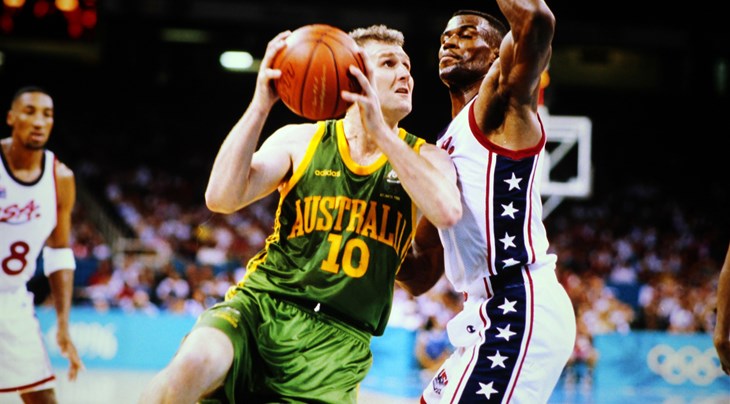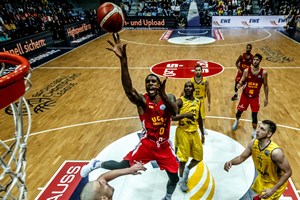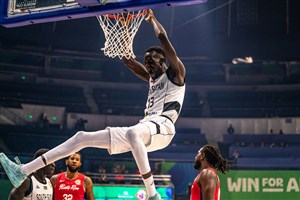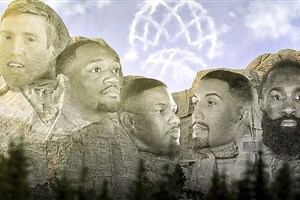
Are these the best Boomers ever?
MELBOURNE (Paulo Kennedy's View from Downunder) - As if the FIBA Asia Cup 2017 hadn't already told us clearly enough, this week's Boomers squad announcement for next month's FIBA Basketball World Cup 2019 Qualifiers games against Chinese Taipei and the Philippines confirmed it.
That is, Australian basketball currently has more depth than at any time in its history.
With Olympians like Chris Goulding, David Andersen, Kevin Lisch, Adam Gibson and Damian Martin alongside the stars of the Asia Cup such as Mitch Creek, Brad Newley, Jason Cadee, Daniel Kickert and Mitch McCarron, it is an embarrassment of riches.
Then it's exciting to see some faces like Alex Loughton, Daniel Johnson and former junior world championship stars Anthony Drmic and Isaac Humphries put into the mix.
ICYMI | The countdown to the Boomers' @FIBAWC qualifiers in Melbourne at @MCourtArena this February is well and truly on with a 24-man squad named ahead of their clashes vs. the Philippines and Taipei: https://t.co/Q5rE8xTul5 #GoBoomers pic.twitter.com/nYxFjhfTqF
— Basketball Australia (@BasketballAus) January 26, 2018
Then there's Ben Simmons, Patty Mills, Aron Baynes, Joe Ingles, Andrew Bogut, Matthew Dellavedova, Thon Maker and Dante Exum from an NBA perspective.
Then add Brock Motum, Ryan Broekhoff, Mangok Mathiang, Ben Madgen, Venky Jois and Jonah Bolden who are also playing overseas, oft-injured duo Nate Jawai and Cam Bairstow and NCAA prospect Jock Landale and it’s getting ridiculous.
That's around 40 players who could all be considered and in most cases relied upon to do a job for their country at different points along the current international basketball spectrum.
If you don't believe me, think that pretty much the same Iranian team that fell to Greece by 25 at the Olympic Qualifying Tournament was beaten by Australia's NBL contingent by 23 points in Lebanon last year.
Further, with the Boomers' best available team from around the world ,their average winning margin over Asian teams at the past four global tournaments was 20 points.
The players who have been asked to step up in the Asia Cup and the first World Cup Qualifiers window have done so at a level that's in line with quality international teams.
Melbourne basketball supporters will get the chance to see further proof against the Philippines on February 22 and Chinese Taipei on February 25.
Depth. We've got it, it's hard to argue there has ever been a time that even comes close to this sort of depth in Aussie basketball, and credit goes to countless folks from junior development ranks all the way up to Andrej Lemanis and his wide-reaching national program.
However, that's not actually what I'm looking at this week.
The question in the header is 'Are these the best Boomers ever?' I’m talking about the pointy end, our best team against the best teams from around the world.
Australia has come fourth at the Olympics on a quartet of occasions, providing four easy candidates, so how do you split them?
For the purpose of this exercise, I'm only factoring in performances against the competition at the time.
Seoul (1988)
Yes, the level of basketball today is light years ahead of where it was in the 1980s and early 1990s, you only have to look at the below video from the Seoul Olympics to see that, but the old saying is you can only beat who's put in front of you.
That 1988 team helped put basketball on the map Downunder, where the Boomers' previous best finish at an Olympics was seventh at a 1984 event weakened without the USSR, the 1988 crew captured the nation with a nail-biting Quarter-Final win over Spain.
They deserve a lot of credit, with a collection of veteran talent like Phil Smyth, Larry Sengstock, Ray Borner and Wayne Carroll achieving success alongside the next generation of Andrew Gaze, Andrew Vlahov, Mark Bradtke and Luc Longley.
But how did they go against the world's best, the other top four from that tournament? Four times they faced Yugoslavia, Soviet Union and the USA, taking home a 0-4 record with an average differential of -23.
Atlanta (1996)
Next up is the 1996 team that also broke new ground, recording an Australian best 4-1 record in the Group Phase to finish second and set up a Quarter-Final clash with Toni Kukoc and Croatia.
Of course, Tony Ronaldson's amazing four-point play is still one of Australia basketball's greatest moments, but how did the 1996 team fare against the top four?
They took home an 0-3 record, and while their six-point Bronze Medal Game defeat to Lithuania was chock full of merit, they ended with an average differential of -19 thanks to blowouts against Yugoslavia and the USA.
Sydney (2000)
Next up is the 2000 Olympic team, who for the first time in Australian basketball history took some serious international-level depth into the tournament.
Wins over Russia in the Group Phase and Italy in the Quarter-Finals were memorable, but this Boomers bunch were caught well short against the top four, going 0-2 with an average differential of -21.
Their 2-4 record against other top eight teams, without a match-up with the USA in Sydney, and an average differential of -10 further adds to the argument that they are not the best performing team in Boomers history.
So the door is wide open for the Rio 2016 team, but did they walk through it?
Rio (2016)
Well they equalled the 1996 team's 4-1 record and second place in the Group Phase, and for the first time in Aussie Olympic history they defeated two European powers in pool play by downing France and Serbia in the first two games.
But, of course, how did they shape up against the very best? Well they replicated the feats of the 2008 and 2012 Olympic teams by beating a top four team, the difference being those two outfits achieved it in dead-rubber games.
That victory over the Serbs saw them leave with a 1-3 record against their fellow medal rounders, with an average differential of -5.5.
Where the 1988, 1996 and 2000 teams were well off the mark against the world's powers in almost every match-up, the 2016 variety had just one bad day in the Semi-Finals, and three highly-impressive performances against the USA, Serbia and Spain.
It makes a pretty strong case that Bogut, Mills, Dellavedova and Co stand tall as our number one team, and their Quarter-Final flogging of Lithuania adds further weight.
Where the 2016 stars triumphed by 26 points in the Last Eight, their three predecessors in the medal rounds each snuck home by a basket in most memorable fashion.
Of course, this column isn't about diminishing those teams' achievements - quite the opposite in fact by bringing them back to light - it's more about highlighting just how good our current team is in an era of immensely-competitive international basketball.
With Simmons to come in, and a number of players such as Bolden, Creek, Exum and Maker with real potential to play important roles, the 2019 and hopefully 2020 teams could be even better.
Aron Baynes says Ben Simmons, Thon Maker & Jonah Bolden are Boomers future as Celtics prepare to face 76ers in London https://t.co/01MGW7Iqrh
— AussieHoopla (@aussiehoopla) January 3, 2018
Paulo Kennedy
FIBA
FIBA's columnists write on a wide range of topics relating to basketball that are of interest to them. The opinions they express are their own and in no way reflect those of FIBA.
FIBA takes no responsibility and gives no guarantees, warranties or representations, implied or otherwise, for the content or accuracy of the content and opinion expressed in the above article.

















